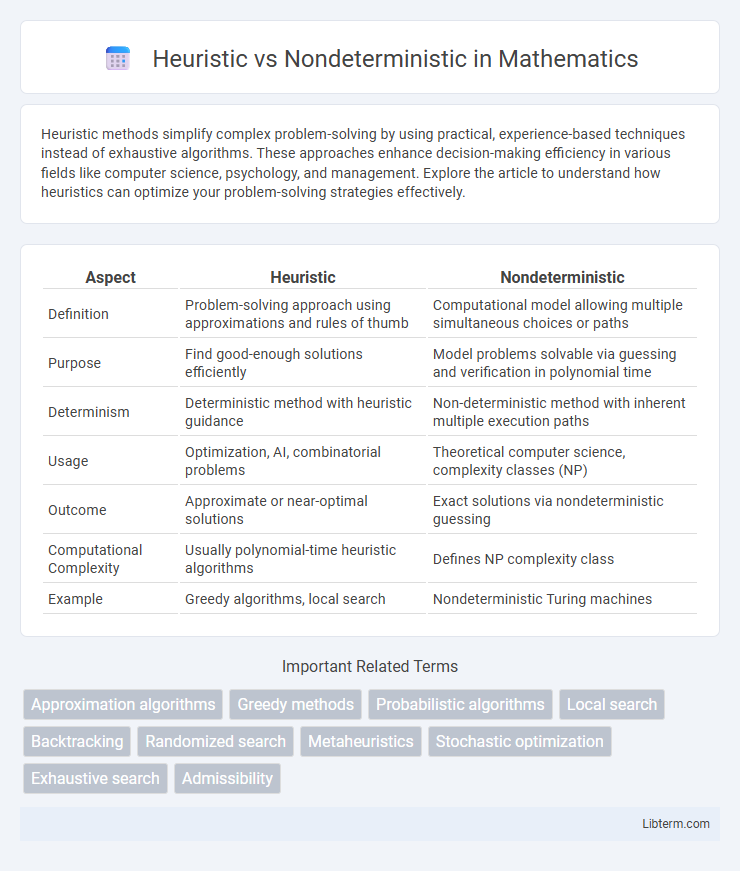Heuristic methods simplify complex problem-solving by using practical, experience-based techniques instead of exhaustive algorithms. These approaches enhance decision-making efficiency in various fields like computer science, psychology, and management. Explore the article to understand how heuristics can optimize your problem-solving strategies effectively.
Table of Comparison
| Aspect | Heuristic | Nondeterministic |
|---|---|---|
| Definition | Problem-solving approach using approximations and rules of thumb | Computational model allowing multiple simultaneous choices or paths |
| Purpose | Find good-enough solutions efficiently | Model problems solvable via guessing and verification in polynomial time |
| Determinism | Deterministic method with heuristic guidance | Non-deterministic method with inherent multiple execution paths |
| Usage | Optimization, AI, combinatorial problems | Theoretical computer science, complexity classes (NP) |
| Outcome | Approximate or near-optimal solutions | Exact solutions via nondeterministic guessing |
| Computational Complexity | Usually polynomial-time heuristic algorithms | Defines NP complexity class |
| Example | Greedy algorithms, local search | Nondeterministic Turing machines |
Introduction to Heuristic and Nondeterministic Methods
Heuristic methods provide practical approaches to problem-solving by using experience-based techniques that generate approximate solutions quickly, making them essential in tackling complex tasks where exact algorithms are infeasible. Nondeterministic methods, often conceptualized in theoretical computer science, involve processes where multiple outcomes are possible from a given state, enabling the exploration of various solution paths simultaneously. Understanding the balance and applications of heuristic and nondeterministic methods is crucial in optimizing computational efficiency and decision-making under uncertainty.
Defining Heuristic Approaches
Heuristic approaches employ problem-solving techniques that use practical methods or various shortcuts to produce solutions that may not be optimal but are sufficient for reaching immediate goals. Unlike nondeterministic methods, which explore multiple possibilities simultaneously often through exhaustive or probabilistic means, heuristics guide the search process using domain-specific knowledge or informed rules. This targeted strategy significantly reduces computational complexity and time, making it valuable in optimization and decision-making tasks where exact solutions are impractical.
Understanding Nondeterministic Algorithms
Nondeterministic algorithms explore multiple computation paths simultaneously, allowing them to solve problems by guessing solutions and verifying correctness efficiently. Unlike heuristic algorithms that rely on approximations or rules of thumb, nondeterministic algorithms model idealized computations where choices lead to successful outcomes without explicit searching. This conceptual framework underpins complexity classes such as NP, highlighting the power of nondeterminism in theoretical computer science.
Key Differences Between Heuristic and Nondeterministic Methods
Heuristic methods employ approximate algorithms to find good-enough solutions quickly, often used in complex optimization problems where exact answers are impractical. Nondeterministic methods, common in theoretical computer science, involve multiple possible computations or guesses simultaneously, typically modeled by nondeterministic Turing machines. Key differences include heuristic approaches prioritizing efficiency and practicality, while nondeterministic methods emphasize theoretical computation models without guaranteed polynomial-time solutions.
Advantages of Heuristic Algorithms
Heuristic algorithms excel in solving complex problems by providing approximate solutions quickly, especially when exact methods are computationally infeasible. They significantly reduce search space and processing time by using rules of thumb or educated guesses, making them ideal for large datasets and real-time applications. These algorithms often outperform nondeterministic methods in practical scenarios due to their scalability and efficiency in finding good-enough solutions.
Benefits and Drawbacks of Nondeterministic Techniques
Nondeterministic techniques offer the benefit of exploring multiple solution paths simultaneously, increasing the probability of finding an optimal or near-optimal solution in complex problem spaces. However, these methods often suffer from high computational costs and unpredictability in execution time, which can limit their practicality in real-time or resource-constrained scenarios. Compared to heuristic methods, nondeterministic approaches may lack efficiency and consistency, but they provide greater thoroughness in problem-solving by avoiding premature convergence on suboptimal solutions.
Real-World Applications of Heuristic Methods
Heuristic methods play a crucial role in solving complex real-world problems where exact solutions are computationally infeasible, such as in routing logistics, scheduling, and artificial intelligence. These approaches use experience-based techniques to find satisfactory solutions quickly, often optimizing performance in dynamic environments like supply chain management and autonomous systems. Unlike nondeterministic algorithms, heuristics rely on practical rules and domain-specific insights to efficiently navigate large search spaces without guaranteeing optimality.
Use Cases for Nondeterministic Algorithms
Nondeterministic algorithms are particularly valuable in solving complex problems like optimization, where multiple potential solutions must be evaluated, such as in scheduling, routing, and resource allocation tasks. They enable exploration of various computational branches simultaneously, making them suitable for applications in artificial intelligence, cryptography, and game theory where uncertainty and probabilistic outcomes are inherent. Unlike heuristics, nondeterministic methods guarantee an exhaustive search for solutions, providing a theoretical basis for algorithms used in NP-complete problems and formal verification.
Choosing Between Heuristic and Nondeterministic Approaches
Choosing between heuristic and nondeterministic approaches depends on the problem complexity and desired solution quality. Heuristic methods prioritize efficiency by applying rule-based shortcuts for near-optimal results, suited for large-scale problems where quick responses are crucial. Nondeterministic approaches explore multiple solution paths using probabilistic or random processes, ideal for problems requiring exhaustive search or when solution optimality outweighs computational cost.
Future Trends in Algorithmic Problem Solving
Future trends in algorithmic problem solving emphasize the integration of heuristic methods with nondeterministic algorithms to enhance efficiency and scalability. Machine learning-driven heuristics are increasingly employed to guide nondeterministic processes, reducing computational complexity and improving solution quality in real-time applications. Advances in quantum computing promise to revolutionize nondeterministic approaches by enabling the exploration of vast solution spaces beyond classical algorithmic limits.
Heuristic Infographic

 libterm.com
libterm.com